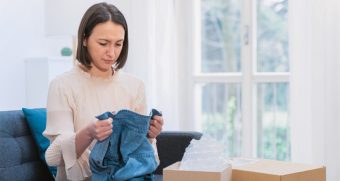How to make an online store
Do you want to make your own online store? Building an online store can be difficult, but there are ways to make it easier. With some patience, curiosity and perseverance, you can make your own online shop without any help.
Building an online shop does not have to be hard
 Do you want to make an online store by yourself? It is possible. Making an online shop does not have to be difficult.
Do you want to make an online store by yourself? It is possible. Making an online shop does not have to be difficult.
A lot of people are afraid, thinking they have to program a checkout or learn code from scratch. But usually, for an ecommerce website that is not at all necessary. If you choose software that has pre-programmed themes and modules, it can be as easy as pie. On the online admin page you can easily make product pages, a menu and a homepage with a built-in checkout.
Making your own online store? You do not need to learn programming.
Preparing your online store
You do not need a programming degree to make an online store, but a little preparation never hurt anybody. Before launching your store online, think about these things first:
- A good company name and domain name
- What you will be selling and at what price
- Who your target audience or ideal customer is
- How much money you are willing to spend at the start
- A short business plan
 These steps are not absolute musts. You will come across them anyway while making your online store. But if you have a clear plan beforehand, creating your shop will be much faster and easier. Just coming up with a name or your domain, for instance, can slow down building your shop for at least a week.
These steps are not absolute musts. You will come across them anyway while making your online store. But if you have a clear plan beforehand, creating your shop will be much faster and easier. Just coming up with a name or your domain, for instance, can slow down building your shop for at least a week.
Do you already have a name for your online store? Make sure it is a good fit. Changing the name of your store at a later time will not be easy. For example, the name should not conflict with other brand names. It should also be easy to remember and recognize, as well as resonate with your target audience.
Start your store easy with an online store builder
 When you start an online store by making it yourself, decide what is within reach. Of course you will not build the next Zalando or Amazon in a day. These ecommerce companies spend millions on their online shops.
When you start an online store by making it yourself, decide what is within reach. Of course you will not build the next Zalando or Amazon in a day. These ecommerce companies spend millions on their online shops.
Every button or color has to be approved by different departments and tested, so they can build the optimal website. Spending lots of money on optimization is not your first priority. Store builders don’t just make it easy or help to make a secure online checkout, they also offer easy payment options or solutions for sales tax in case you send cross border.
When you create an ecommerce store with an online store builder it is possible to launch something quite fast and easy. The more difficult improvements you can keep for a later moment, when you have the budget to hire some help. There is always room for improvement later.
With an online store builder it is possible to launch an ecommerce site quite fast and easy.
Choosing software for your online shop
Making a plan for your online store also means choosing your ecommerce software wisely. If you want to make your own store without programming it from scratch, you will need software that makes this a breeze. Software such as WordPress is popular for a regular website, but for ecommerce platforms like Shopify, Lightspeed or Bigcommerce are also well suited for the task.
Shopify
 Shopify is a cloud-based ecommerce platform, powering over 1 million online businesses worldwide. Shopify can be used to sell products online and in person. It offers built-in tools to help you create and analyze digital marketing campaigns, and offers a single dashboard to manage orders, shipping and payments. It now offers a 3-day free trial and 1 dollar per month for 3 months on all plans.
Shopify is a cloud-based ecommerce platform, powering over 1 million online businesses worldwide. Shopify can be used to sell products online and in person. It offers built-in tools to help you create and analyze digital marketing campaigns, and offers a single dashboard to manage orders, shipping and payments. It now offers a 3-day free trial and 1 dollar per month for 3 months on all plans.
Webador
 With no technical knowledge required, Webador's user-friendly drag-and-drop website builder is ideal for launching a webshop. Easy to use steps make it easy to customize your site yourself. Normally a steal at just €9 per month, users can now get started for a promotional price of €1 per month.
With no technical knowledge required, Webador's user-friendly drag-and-drop website builder is ideal for launching a webshop. Easy to use steps make it easy to customize your site yourself. Normally a steal at just €9 per month, users can now get started for a promotional price of €1 per month.
Lightspeed eCommerce
 Lightspeed eCommerce is a cloud-based solution to buy an online store with, that is extra convenient for omnichannel retailers. It enables them to manage in-store and online inventory, view all customer information and analyze multi-channel sales data, all from one system.
Lightspeed eCommerce is a cloud-based solution to buy an online store with, that is extra convenient for omnichannel retailers. It enables them to manage in-store and online inventory, view all customer information and analyze multi-channel sales data, all from one system.
A free online store with WordPress
 Thousands of people have built their shop with software solutions such as the three options above. WordPress is another popular solution. In combination with a plugin such as WooCommerce, you can make your online store for free. Keep in mind that this software solution needs more skills and online experience. Platforms such as WordPress, Adobe Commerce or Prestashop are open source and that often makes it less convenient if you are first starting out.
Thousands of people have built their shop with software solutions such as the three options above. WordPress is another popular solution. In combination with a plugin such as WooCommerce, you can make your online store for free. Keep in mind that this software solution needs more skills and online experience. Platforms such as WordPress, Adobe Commerce or Prestashop are open source and that often makes it less convenient if you are first starting out.
For one, they are much more complex. And if you do not have outside help, the stability and safety of your store is not guaranteed. Especially if you want to make use of extra plugins or your own piece of code. Open-source software is much more work. And if you are on your own, there is no easy guide or customer service available.
Default store themes are fully developed
 If you have never made a website design before, you can start your online store with a default design and theme.
If you have never made a website design before, you can start your online store with a default design and theme.
This means the design of your store may not be the most beautiful or unique, but that does not have to be a bad thing. Those pre-programmed options are usually made by the software company itself. These companies have years of experience, so the default themes and modules will be fully developed. Even a simple template can generate sales, plus you will have it online in no-time.
Making online product pages
If you have chosen software to make your online store, it is time to get to work. Usually your software provider has some steps to follow, such as providing your contact information, bank account for payments, choosing a theme and creating your homepage.
Even though the theme is important for the overall design and you probably want to create the homepage right away, it is better to look at product pages first. Your visitors will usually not enter your website via the homepage but through a specific product. This means your product page is the most important page of your webshop.
The product page is the most important page of your shop. Start with this first and take your time.
Your product page has a few different functions. Because customers will most likely enter the webshop this way, it has to inspire. But also, the product page needs detailed information about the product. You want to inform and seduce your customer to click on the order-button.
What needs to be on your product page?
For an online store the product page has a big impact and it is important to take your time for it. To create a product page, you need products to sell first. Take clothing for example. You will need to provide the following information:
- Product name
- Product image (preferably more than one)
- Product description
- Price
- Delivery time
- Details (size, color, material, etcetera)
This information will also be provided by your supplier, but do not just copy and paste. Your supplier will have factual information, but does not adjust it to your target customer. Of all places, this is where it pays off to be creative. It can make a world of difference.
When people start an online shop, they are afraid to scare off customers if they are overselling a product. But the opposite is true. If you are not specific about what makes this product special, no one will want to buy it. Think of your target audience and speak to them through your website texts and images. Why would they want to buy your product?
Product images
 Do not make the mistake of using the product images or descriptions directly from your supplier.
Do not make the mistake of using the product images or descriptions directly from your supplier.
Make sure customers can see the fabric and fit of, for example, a clothing item. This will eliminate any doubts they might have. Also order the item yourself and see how it feels. But most of all: create your own product images and desciptions. Make sure they are of good quality and use a model or environment that matches your ideal customers.
Make your own product images and descriptions that speak to your ideal customer.
Making category pages
If your inventory only consists of ten or twenty items, you can stick to product pages without creating product categories. But usually online stores want to go big, and if you have different types of products, you want to make it easy for customers to browse.
If we go back to the example of clothes, you can imagine having categories like women’s, men’s and children’s clothing. One level deeper you might have a category for sweaters and one for pants. How you create these categories can be different depending on your software. Usually you can create a dropdown-menu, but you can also tag certain types of products so they all appear under the label ‘sweaters’. The last option is usually easier because you can use multiple tags for one item, such as ‘women’s clothing’ and ‘pants’.
Does a successful online store need categories?
Category pages, like anything, have pros and cons. The downside to categories is that they are fairly general. This makes for greater competition on search terms, and the intention to buy smaller. Your category menu can also become clogged up, which makes it harder to find a certain item.
Product categories can also work in your favor, however. Products, for example, can be sold out or out of stock. Instead of going to another shop for a blue sweater, your customer might find a similar product on your category page. Category pages are also not subject to a lot of changes. Therefore they are useful marketing tools over time with low maintenance.
Creating navigation
 If you have a list of product pages and categories, it is time to look at your navigation menu. Usually your software does this automatically, but it is useful to see if you want to make any changes. For example, how many items does your menu have and in what order do they appear?
If you have a list of product pages and categories, it is time to look at your navigation menu. Usually your software does this automatically, but it is useful to see if you want to make any changes. For example, how many items does your menu have and in what order do they appear?
A good rule of thumb is that a menu is up to seven items long. If you have ten categories plus an ‘about us’ page and homepage, it is useful to insert a submenu. Always aim for a menu that is as short as possible, so customers do not drown in options and keep a good overview.
Keep in mind that users read your website from left to right and from top to bottom. Therefore it is best to have the menu at the top or left of your webshop. The most important page should be the first in the menu. When customers are looking for inspiration, they should find what they are looking for. Your regular customer is willing to look a bit further, so any extra information such as your privacy or return policy can reside in a footer-menu.
Customizing your design
Now that you have the basic outlines of your store, it is time for the fun part: the design of the shop. As mentioned before, your software provider will probably have some pre-programmed themes to choose from. Now, of course you can go all out and create your own, but it is perfectly fine to choose a default theme for your store and customize it as you go along. Think about inserting your logo, a tagline or customizing your menu to make it your own.
It is perfectly fine to choose a default theme for your store and customize it as you go along.
A default theme may not be unique, but usually your customer will be none the wiser. Your visitors will not notice that your font, colors or order-button resembles that of another shop. An added bonus is that a default theme is compatible for all screens. So whether a customer visits your shop via desktop, laptop or mobile, it will always look good.
Additional pages
 Now that your online store is looking nice, you can focus on the details. There is some information that needs to be on your website, either by law or just to inform customers about your service. Some information may already be there, such as the contact information you provided when first setting up your shop. But there is more to be added.
Now that your online store is looking nice, you can focus on the details. There is some information that needs to be on your website, either by law or just to inform customers about your service. Some information may already be there, such as the contact information you provided when first setting up your shop. But there is more to be added.
Adding the following pages will ensure your online shop is following rules and regulations:
- Contact page
- About us page
- Privacy policy and cookies
- Warranty and terms of service
- Return policy
For starters, you will need to provide necessary legal information about your company. Such as an address, commercial registry and VAT-number. This can be part of your contact page, but an about page is also recommended. Here you can showcase why you started your company and what your mission statement is.
You are obligated to provide company and legal information in your online shop.
Besides company information, you are required to inform customers about shipping costs, delivery and your return policy and warranty. Cost of shipping and delivery time are good to mention on your product page, so that customers know what to expect. Further details, such as the customers right to cancel their order within 14 days, can be placed on a separate page. Since your return policy and warranty often include a lot of legal information, set this aside on a separate page too. And do not forget about cookies and privacy policy.
You are probably tempted to hide legal information away, because it takes up valuable room in your shop’s design. But remember that customers must have easy access to this information before placing an order. If it is too hard to find, you may have legal trouble down the line. Linking to these pages in your footer-menu is a good way to make it accessible, while still having a slick homepage.
Checkout and payment options
 Are you afraid of programming a complex checkout-system for payments? Don’t be. The checkout is usually set up and ready to go within your software platform. Shopify, for example, has the checkout already built-in. If your software does not have this, there are payment service providers to do this work for you.
Are you afraid of programming a complex checkout-system for payments? Don’t be. The checkout is usually set up and ready to go within your software platform. Shopify, for example, has the checkout already built-in. If your software does not have this, there are payment service providers to do this work for you.
Services such as Mollie or Adyen, for example, provide safe payment options to easily plug in to your shop. You usually pay per month or per transaction. The only thing you have to do is choose which payment options you want to have, such as creditcard and PayPal. You are also legally required to have a payment option after delivery. Most shops use creditcard for this, but you can also use ‘buy now pay later’ options such as Klarna or Afterpay.
Shipping and delivery information
 You have to inform customers about shipping before they place an order. But it is also important to update them about the delivery afterwards. Customers are probably excited about their purchase and want to know when it arrives. E-mail them an update about the shipment status, for example.
You have to inform customers about shipping before they place an order. But it is also important to update them about the delivery afterwards. Customers are probably excited about their purchase and want to know when it arrives. E-mail them an update about the shipment status, for example.
You can do this yourself, or let shipping software do it for you automatically. You can even outsource the entire shipping process to these platforms. For example, if you let Sendcloud ship your orders, you can use their software for free. Platforms such as these will take care of everything, from the shipping label to the delivery itself.
If you are just starting an online store, this is a good deal. It’s usually cheaper than going to the post office yourself for a handful of packages a week. These platforms work for thousands of online shops and automatically offer track and trace-updates for customers.
Looking to outsource your fulfillment? Salesupply and ShipBob are fulfillment partners with multiple European warehouse locations, making it possible to offer next day delivery all over Europe.
Your store’s homepage
The homepage is the first page visitors will see after entering your website’s address. It is a common mistake to design the homepage right away, before you have an idea of what your webshop will actually be like. But there is a reason to save the best for last. Now that you have an idea of the foundations of your online shop, you can put the cherry on the cake.
Less is more. Only select the most important things to display on your homepage.
It is time to decide what products you want to showcase on your homepage. But do not get carried away. Less is more, so just select the most important things. One product, button or body of text too many and your customer will lose focus. Search engines will also favor less hyperlinks on your homepage.
Testing your online shop
 By now you will have added products, put them into categories, created a menu, additional pages and last but not least, your homepage. You will have tweaked the design to show off your company name, logo, tagline and custom images. Time to flip the switch and launch your online shop for the world to see? Not just yet. First, test your store to see if everything works like it is supposed to.
By now you will have added products, put them into categories, created a menu, additional pages and last but not least, your homepage. You will have tweaked the design to show off your company name, logo, tagline and custom images. Time to flip the switch and launch your online shop for the world to see? Not just yet. First, test your store to see if everything works like it is supposed to.
Place a fake order and see what happens.
Place a fake order and see what happens. Was it easy to find a product, add it to your cart and proceed to checkout? Were you able to pay without the website crashing? Try it in different browsers and on several devices, such as desktop and mobile. Then make sure that you received a confirmation e-mail. One for the customer, plus a notification for the shop’s owner that an order was placed. After trying it out yourself, invite friends and family to test your shop. They may spot things that you overlooked. Was the experience user friendly? And what could be better?
Time to launch!
After trying and testing your new shop, it is finally time to launch. Hit the live-switch and spread the word about your online store. Next steps are the online marketing, or search engine optimization to get those visitors. Enjoy being an entrepreneur and packing your first orders. Congratulations and good luck!